|
FEATURE
Desert Power: A Solar Renaissance
Carolyn Gramling
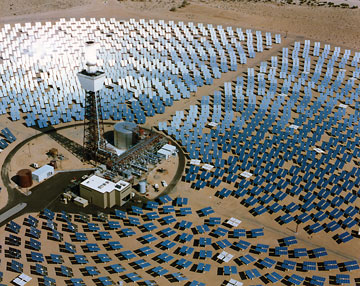 Courtesy of DOE/NREL, Credit - Sandia National Laboratories |
| A Department of Energy-sponsored pilot solar thermal project built in California’s Mojave Desert in 1981, shown here, was a 10-megawatt power tower surrounded by more than 1,800 sun-tracking mirrors. |
Sandy wastes, brutal sun, forbidding emptiness — those are the stark images of a desert. But these vast, sunburnt areas are also home to a powerful renewable energy resource: the sun. And solar energy is likely to become increasingly important as the world looks ever more urgently for alternatives to fossil fuels.
A recent renewed interest in alternative energy technologies has also revitalized interest in solar thermal technology, a type of solar power that uses the sun’s heat rather than its light to produce electricity. Although the technology for solar thermal has existed for more than two decades, projects have languished while fossil fuels remained cheap. But solar thermal’s time may now have come — and mirrored arrays of solar thermal power plants may soon bloom in many of the world’s deserts.
Solar rising
As a result of the oil crises of the 1970s, alternative energy sources, including solar power, received increased attention. From the mid-1970s through the mid-1980s, the solar industry grew from 45 solar collector manufacturing firms to 225 firms, according to the U.S. Energy Information Administration (EIA). During this period, construction began on nine solar thermal power plants, collectively referred to as the Solar Energy Generating Systems (SEGS), in California’s Mojave Desert. These power plants — still the largest solar plant system in the world — were hybrids, using solar energy by day but fossil fuels at night.
In the late 1980s, oil prices fell and remained low through the 1990s — and construction of new solar plants stalled. But more recently, with oil prices soaring past $100 per barrel, solar power has once again become economically attractive. In the United States, the solar energy industry has been growing rapidly since 2003, fueled not only by high energy prices but also by an increased focus on reducing carbon emissions, as well as by new renewable power standards in many states and federal tax credits for solar installations (which went into effect in January 2006 as part of the Energy Policy Act of 2005).
They do it with mirrors
When it comes to solar power, many people are most familiar with photovoltaic cells. These cells convert sunlight to electricity by absorbing photons from the sun’s rays; the photons kick some electrons loose from atoms of silicon in the cells, and the resulting flow of electrons through the material produces electricity.
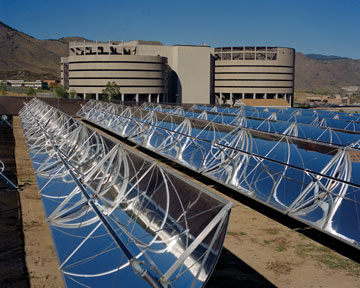 Courtesy of DOE/NREL, Credit - Dave Parsons |
| The Jefferson County jail in Golden, Colo., uses a parabolic trough solar thermal system to provide hot water to the facility, meeting 50 percent of its hot water needs. |
In addition to providing electricity, hot water and heat to homes and businesses, photovoltaic systems supply power to everything from ocean weather buoys and communications equipment to streetlights and satellites. But cost is an issue: Photovoltaic solar power is still more expensive than electricity generated by fossil fuels, costing between 10 and 40 cents per kilowatt hour, depending on whether it comes from a solar power plant or from cells on a small building. Coal, on the other hand, costs 2 to 4 cents per kilowatt hour.
Some of the high costs relate to the costs of raw materials used to manufacture the cells, such as copper and high-grade silicon. Newer thin-film solar cells (using a very thin coating of silicon or an alternative) cost less than conventional crystalline silicon technology to manufacture, but also tend to be less efficient (producing less power with the same amount of sunlight).
However, there is a way to “boost” solar power to make it more affordable: Instead of converting sunlight to electricity, solar thermal power plants, also called concentrated solar power (CSP), harness the sun’s energy by converting it — with the help of mirrors that focus the intense energy — to heat. There are several different configurations of mirrors that CSP plants can use. Some plants — such as the California SEGS plants — use “parabolic troughs,” curved mirrors that focus the energy onto pipes containing circulating oil, which absorbs the energy and uses it to heat steam to power a standard generator.
Another kind of concentrating solar technology, solar “power towers,” uses a large field of sun-tracking mirrors called heliostats that face a central tower and focus the solar energy onto a receiver on its top. The intense energy concentrated onto the tower produces temperatures up to 1,500 degrees Celsius (2,732 degrees Fahrenheit). That thermal energy then heats up water, producing steam that drives a turbine to produce electricity.
More recently, an innovation to temporarily store the heat, improves on one of solar energy’s primary limitations — the inherent intermittency of sunlight. Many newer plants use insulated tanks filled with molten salt for heat storage, which — although only possible for a few hours — means the plant can still provide power on cloudy days or at night. Such technological advances, combined with an economic atmosphere once again receptive to alternative energy, have created new interest in solar thermal.
Renewed interest in renewables
When it comes to solar thermal energy, “‘renaissance’ is the term I hear a lot,” says Ben Paulos, program officer for renewable power at the Energy Foundation in San Francisco, Calif. Formed in 1990 as a partnership of 15 to 20 large foundations, the Energy Foundation’s goals are to fund research and new technologies for renewable energy in both the United States and China, two of the world’s biggest energy markets.
High oil prices aren’t the only reason that “Big Solar” is gaining increasing interest, Paulos says. Also key is the recent adoption of renewable power standards in many states (currently 25), requiring that state utilities buy a growing amount of renewable power each year. Concentrated solar power, one option to help meet these standards, requires a lot of intense sunlight — and in the United States that means the Southwest. The region is particularly well matched to solar power because power loads (intense sunlight) and power needs (intense air conditioning) coincide at midday. Within that region there is plenty of local demand for solar power — more, in fact, than the utilities can currently satisfy, he says. “That’s the thing that makes the Southwest so attractive for concentrated solar power. Not only is the resource there, but demand is there, and power prices are high enough to pay for it.”
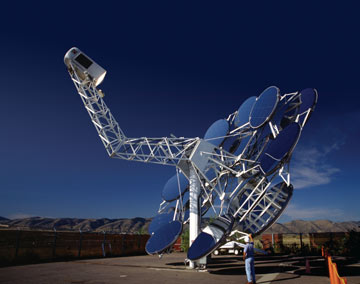 Courtesy of DOE/NREL, Credit - Dave Parsons |
| Stirling Energy Systems and utility Southern California Edison are building a 500-megawatt solar power plant to open in 2009. The plant will be the first commercial application of the Stirling Solar Dish (a smaller prototype is shown here at the National Renewable Energy Laboratory in Golden, Colo.). |
The utility sector in western states has therefore become especially interested in solar, with several new projects recently constructed — and many more proposed. For example, the Nevada Solar One solar thermal plant, which came online in June 2007 and uses solar power towers to produce 64 megawatts of power, is one of the largest solar plants built in the last 16 years, according to EIA. Spread across more than 160 hectares of the El Dorado Valley near Las Vegas, the plant’s nearly 219,000 mirrors concentrate sunlight onto 18,000 receiver tubes, generating enough electricity to power 15,000 households.
Other proposals are hot on Nevada Solar One’s heels. In February, the Spanish company Abengoa Solar filed for approval for a new solar thermal plant to be built in a hot patch of land southwest of Phoenix, Ariz., called Gila Bend, where summer temperatures can reach up to 48 degrees Celsius (120 degrees Fahrenheit). If approved, the plant would produce 280 megawatts, enough to supply 70,000 homes with power. Arizona’s renewable power standards will require state utilities to get 15 percent of their electricity from renewable sources by 2025 — and state officials say the Abengoa plant would be a big boost to meet those standards, bumping them up to 5 percent by 2011.
In 2005, the utility Southern California Edison (the nation’s leading purchaser of renewable energy) announced a contract with the solar company Stirling Energy Systems to construct a giant solar-power generating station northeast of Los Angeles. The power station is intended to produce 500 megawatts of power, which would make it the world’s largest. The station would use a new type of solar technology that has been successfully tested at Sandia National Laboratories in Albuquerque, N.M., but never deployed. The project consists of a dish-shaped mirror array (eventually to include about 20,000 dishes) that focuses the sun’s rays on a receiver connected to a Stirling engine, heating up hydrogen gas that expands and drives the pistons of an engine (which resembles an internal combustion engine).
Internationally, sunny Spain has been a leader in solar power, not only financing projects in the United States, but implementing its own solar thermal projects. In March 2007, a solar-power tower plant was constructed near Seville; the plant currently produces 11 megawatts but plans to increase production to 300 megawatts by 2013. And two 50-megawatt parabolic trough plants are in construction in Andalucia, one of which will be completed this summer.
Desert power
But an even larger project is on the table, spanning not only Europe but also North Africa and the Middle East. The sunburnt Sahara Desert seems like an obvious place to harvest solar energy — but a multinational initiative, dubbed “Desertec,” plans not only to harvest solar thermal energy from proposed plants in North Africa (and the Middle East) for local use, but to transfer much of that energy across the Mediterranean Sea to European consumers. If it succeeds, proponents say, Desertec will not only provide affordable, renewable solar power to two continents — eventually supplying one-sixth of Europe’s power needs — but will also help to promote political and financial stability.
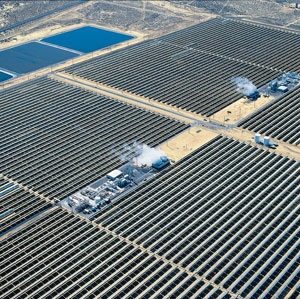 Solar Millennium AG |
| Aerial view of the parabolic trough solar power plants at Kramer Junction in California. |
The project began six years ago, when German physicist Gerhard Knies began to consider the possibility of solar power from the world’s deserts as the most promising source of clean, renewable energy. The success of California’s SEGS plants demonstrated that the technology is not a limiting factor, and that solar power can be competitive economically, Knies says. What’s been missing, he notes, is political will to wean nations off of fossil fuels.
In 2003, he approached the Club of Rome, a global think tank that consists of scientists, businessmen and current and former heads of state from around the world, hoping to enlist their help in determining the feasibility of using this source. They were interested, he says, but skeptical: “They said we’d need a disaster first before people will change.”
Still, that year Knies and other members of the Club of Rome formed the Trans-Mediterranean Renewable Energy Cooperation (TREC). TREC began to develop the Desertec concept, a sweeping plan to build an array of solar thermal power plants in North Africa and the Middle East that would transmit power to Europe. Desertec was intended not only to provide energy, but also water and security, while reducing harmful carbon dioxide emissions and promoting peaceful relations and cooperation between the countries.
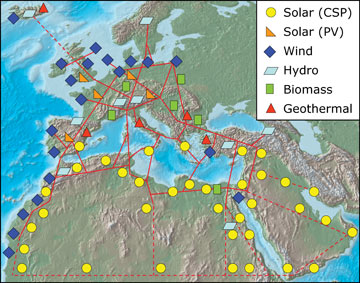 TREC |
| TREC’s vision of a sustainable energy future for Europe, the Middle East and North Africa: A super-grid of solar thermal power plants and other renewable energy sources such as wind, hydroelectric and geothermal fully powers the region. |
A similarly ambitious vision of mutually beneficial relationships across the Mediterranean has been attempted before, but previous attempts to forge stronger political, economic and social relationships between the member states of the European Union and states in the Middle East and North Africa have stalled, because there was limited demand for goods from the southern countries, Knies says. But, he says, what they do have is sun power.
Reaching across the sea
TREC began a series of studies and seminars with world experts on the issue, which showed that affordable solar thermal power was possible — and by 2006, skyrocketing fossil fuel prices began to make it look even more economically attractive. In April 2006, TREC issued a report by the German Aerospace Center that found that using less than 0.3 percent of the deserts of North Africa and the Middle East, thermal solar power would meet a large chunk of Europe’s electricity needs — at a cost less than oil.
In November 2007, TREC presented the Desertec proposal to the European Parliament in Brussels, Belgium. At a cost of nearly $400 billion over the next 30 years, the power stations in the desert — more than a hundred initially, but ultimately perhaps thousands, according to the Desertec plan — could not only meet much of Europe's energy demand by 2050, but also two-thirds of the energy needs of North Africa and the Middle East, according to the proposal.
In addition to providing Europe with power and cutting carbon emissions, TREC says another benefit of the thermal power plants is that the excess heat from the plants could be used for desalination. Each plant has to be cooled “like the engine of a car,” Knies says, and using saltwater to do the cooling would be an effective method of desalination: The water would evaporate, leaving the salt behind, and could then be recondensed.
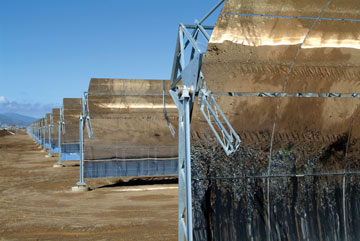 Gollmer/Solar Millennium AG |
| The first European parabolic trough power plant, Andasol 1, will be completed this summer. The plant, located in the province of Granada, Spain, will have a capacity of 50 megawatts and a molten salt reservoir (below) to store heat overnight. |
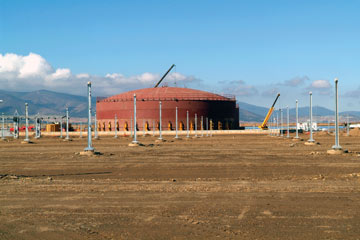 Gollmer/Solar Millennium AG
|
There are potential roadblocks, however. The power would be carried by undersea cables across the Mediterranean to EU member stations, and how much energy would be lost during the long transit — and whether that would make the plan less economically attractive — is one concern. The Desertec proposal says, however, that by using high-voltage direct current transmission lines, like the ones commonly used on land, to carry the electricity across the sea, very little energy would be lost.
Political instability in the Middle East and North Africa is also a concern to investors, and the transmission lines could be vulnerable, Knies acknowledges. However, he adds, there are many ways to disrupt society, and power lines out in the empty desert “could be protected better than power lines that go through a busy country,” he says. But the more important point, he notes, is that the project itself — which, he says, would benefit both home and destination countries — is an incentive to keep things running smoothly.
Whether the European Union will ultimately be convinced by that pragmatically utopian argument isn’t yet clear, however. In November, the European Union asked TREC to provide more specifics on the proposal, including how it might protect potential (and apprehensive) investors from financial loss in the case of attacks and other effects of political instability in North Africa and the Middle East.
Waiting for a “green” light
Political will may also be a stumbling block for solar power in the United States. Although U.S. developers are currently sifting through dozens of proposed solar thermal projects, one issue that may slow — or even temporarily halt — the growth of U.S. solar thermal technology is that the federal tax credit for solar power is due to expire at the end of this year, Paulos says. Last December, the House of Representatives voted to extend that tax credit, but there was a wrinkle: To pay for that program, other programs would have to be cut. And the House’s plan — to offset the tax credit’s cost by repealing some recent tax breaks for the oil industry — was voted down by the Senate. In February, the House again voted to extend the tax credit, but the Senate may overturn that again when it addresses the bill this spring, and if no compromise is reached, the credit may expire.
A short-term slowdown in solar expansion as a result of that expiration could have dire consequences for the U.S. solar industry, Paulos says. “If the bill is killed … developers will sit and wait while people get put out of work,” he says. Meanwhile, he adds, investors will be reminded that solar ventures can be risky, and the U.S. could lose its prominent place in the rapidly expanding international solar market.
In the long term, however, a solar slowdown could spell worse trouble for utilities, as new cap-and-trade limits for carbon emissions become mandatory. In 2006, California signed into law the world’s first legislation to cap carbon emissions, pledging to reduce emissions by 25 percent by 2020 — and other states and regions are now considering similar legislation. Meanwhile, five states — Arizona, California, New Mexico, Oregon and Washington — signed the Western Regional Climate Action Initiative in February 2007. The initiative has jointly set a regional emissions target, and plans to establish a market-based system to reduce emissions by August 2008.
Solar thermal power, with no carbon emissions, has the potential to play a large role in helping utilities in those states meet that goal. “The big long-term driver is climate change,” Paulos says. “It’s pretty clear that there will be a price on carbon emissions pretty soon,” perhaps as soon as 2009 under the next presidential administration, he says. Therefore, although solar thermal may face a serious bump in the road in the short term, the long-term prognosis is good, he adds. “We are seeing utilities who are much more serious about solar than they have ever been.”

 Subscribe
Subscribe


